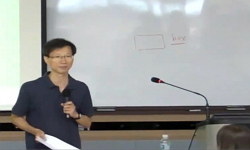The purpose of this study is to systematically review the feasibility of the failure of the corporate education and training market and the government’s intervention in the vocational education and training market through the analysis of corporate e...
http://chineseinput.net/에서 pinyin(병음)방식으로 중국어를 변환할 수 있습니다.
변환된 중국어를 복사하여 사용하시면 됩니다.
- 中文 을 입력하시려면 zhongwen을 입력하시고 space를누르시면됩니다.
- 北京 을 입력하시려면 beijing을 입력하시고 space를 누르시면 됩니다.

기업 교육훈련의 시장 실패와 정부 개입의 효과 분석 = Analysis on Market Failure and Government Intervention of Vocational Education and Training in Corporations
한글로보기https://www.riss.kr/link?id=A108636457
- 저자
- 발행기관
- 학술지명
- 권호사항
-
발행연도
2023
-
작성언어
Korean
- 주제어
-
등재정보
KCI등재
-
자료형태
학술저널
- 발행기관 URL
-
수록면
153-177(25쪽)
- 제공처
- 소장기관
-
0
상세조회 -
0
다운로드
부가정보
다국어 초록 (Multilingual Abstract)
The purpose of this study is to systematically review the feasibility of the failure of the corporate education and training market and the government’s intervention in the vocational education and training market through the analysis of corporate education and training investment. To empirically review this, panel regression analysis was conducted using the 4th to 7th data of the Human Capital Enterprise Panel Survey I. The investment index of companies’ education and training was set as education and training expenses compared to labor costs and per capita education and training expenses, and the independent variables were set as participation in government projects and market failure. The analysis results are as follows. First, no evidence has been found that market failure due to the problem of manpower theft has a significant effect on companies’ investment in education and training. However, the government’s intervention was found to positive effect the investment in education and training expenses per capita compared to labor costs. Second, the control variable found that the ratio of women, the ratio of regular workers, the age of companies, the size of companies, and the presence or absence of unions affect investment in education and training. Based on these empirical analysis results, a plan was proposed to increase the effectiveness of the government’s intervention in education and training
국문 초록 (Abstract)
본 연구의 목적은 기업 교육훈련에서 관련 변인들을 통제한 후, 시장실패와 정부 개입의 효과성을체계적으로 분석하는 것이다. 이를 실증적으로 검토하기 위해 인적자본기업패널조사Ⅰ 4∼...
본 연구의 목적은 기업 교육훈련에서 관련 변인들을 통제한 후, 시장실패와 정부 개입의 효과성을체계적으로 분석하는 것이다. 이를 실증적으로 검토하기 위해 인적자본기업패널조사Ⅰ 4∼7차 자료를 활용하여 패널회귀분석을 실시하였다. 기업의 교육훈련 투자 지표는 인건비 대비 교육훈련비와 1 인당 교육훈련비로 설정하고 독립변수는 정부사업 참여와 시장실패로 설정하였다. 분석 결과는 다음과 같다. 첫째, 인력 탈취 문제로 인한 시장실패는 기업의 인건비 대비 교육훈련비와 1인당 교육훈련비 투자에 유의한 영향을 미친다는 근거가 파악되지 않았다. 그러나, 정부의 개입은 인건비 대비 교육훈련비와 1인당 교육훈련비 투자에 정적인 영향을 미치는 것으로 나타났다. 둘째, 통제 변수에서는여성 비율, 정규직 비율, 기업연령, 기업 규모, 노조 유무가 교육훈련 투자에 영향을 미치는 것으로나타났다. 이러한 실증분석 결과를 바탕으로 정부의 교육훈련에 대한 개입 효과성을 높일 수 있는방안을 제시하였다.
참고문헌 (Reference)
1 채창균, "훈련 이수자 실태조사연구" 한국직업능력개발원 2008
2 송민수 ; 김동주, "헌신형 인적자원관리, 노조조직률, 사용자의 노사관계전략이 여성의 관리자 진출에 미치는 영향에 대한 탐색적 연구" 한국노동연구원 19 (19): 123-155, 2019
3 류장수, "한국제조업체의 교육훈련투자규모와 결정요인" 45 (45): 227-249, 1997
4 노경란 ; 변정현 ; 허선주 ; 임현선, "한국기업의 교육훈련비 투자 결정요인 분석 - 2005~2009년도 인적자본기업패널 자료를 중심으로-" 한국인력개발학회 13 (13): 1-27, 2011
5 요코타 노부코, "한국 노동시장의 해부: 도시 하층과 비정규직 노동의 역사" 그린비 2020
6 김안국, "한국 기업의 교육훈련 결정요인-시장실패와 정부 개입을 중심으로-" 한국노동경제학회 31 (31): 105-133, 2008
7 김진영, "직업훈련정책과 시장실패 정부실패 : 비교의 관점에서" 8 (8): 155-183, 1999
8 안선민, "직업훈련의 정부실패 치유 노력에 대한 성과와 한계: 민간자율형 일학습병행 시범사업 사례" 국가정책연구소 36 (36): 27-52, 2022
9 김주섭, "직업훈련 참가결정에 관한 연구" 2 (2): 81-100, 2002
10 유경준, "직업능력개발과 시장실패에 관한 연구" 한국기술교육대학교 2018
1 채창균, "훈련 이수자 실태조사연구" 한국직업능력개발원 2008
2 송민수 ; 김동주, "헌신형 인적자원관리, 노조조직률, 사용자의 노사관계전략이 여성의 관리자 진출에 미치는 영향에 대한 탐색적 연구" 한국노동연구원 19 (19): 123-155, 2019
3 류장수, "한국제조업체의 교육훈련투자규모와 결정요인" 45 (45): 227-249, 1997
4 노경란 ; 변정현 ; 허선주 ; 임현선, "한국기업의 교육훈련비 투자 결정요인 분석 - 2005~2009년도 인적자본기업패널 자료를 중심으로-" 한국인력개발학회 13 (13): 1-27, 2011
5 요코타 노부코, "한국 노동시장의 해부: 도시 하층과 비정규직 노동의 역사" 그린비 2020
6 김안국, "한국 기업의 교육훈련 결정요인-시장실패와 정부 개입을 중심으로-" 한국노동경제학회 31 (31): 105-133, 2008
7 김진영, "직업훈련정책과 시장실패 정부실패 : 비교의 관점에서" 8 (8): 155-183, 1999
8 안선민, "직업훈련의 정부실패 치유 노력에 대한 성과와 한계: 민간자율형 일학습병행 시범사업 사례" 국가정책연구소 36 (36): 27-52, 2022
9 김주섭, "직업훈련 참가결정에 관한 연구" 2 (2): 81-100, 2002
10 유경준, "직업능력개발과 시장실패에 관한 연구" 한국기술교육대학교 2018
11 최계원 ; 이영민, "중소제조기업 교육훈련 투자 영향요인에 관한 분석" 한국기업교육학회 24 (24): 65-87, 2022
12 김기근, "중소기업의 교육훈련의도 및 실행에 영향을 미치는 조직요인과 상황요인에 관한 연구" 영남대학교 대학원 2011
13 황성수, "우리나라 기업의 교육훈련투자 현황과 시사점" 19 (19): 8-18, 2016
14 전승훈 ; 강성호 ; 임병인, "선형패널자료 분석방법에 관한비교연구" 통계청 9 (9): 1-24, 2004
15 박성재, "사업주훈련이 기업성과에 미친 영향에 관한 연구" 368-389, 2007
16 유경준, "사업주직업능력개발지원사업" 한국개발연구원 2009
17 반가운, "사업주 직업훈련지원제도가 교육훈련투자 성과를 촉진하는가? -기업규모 간 비교를 중심으로-" 한국노동경제학회 36 (36): 95-124, 2013
18 김주섭, "노사 참여적 직업능력개발에 관한 연구. 근로자 학습재원 운영방안을 중심으로" 한국노동연구원 2003
19 김세화 ; 유보람, "노동조합이 인적자원개발에 미치는 영향에 관한 문헌 연구" 한국산업교육학회 41 (41): 1-29, 2021
20 이희선 ; 권다영 ; 최충, "노동조합이 교육훈련에 미치는 영향" 한국노동경제학회 43 (43): 179-203, 2020
21 이병희, "기업훈련지원제도의 특성과 효과에 대한 연구" 한국노동연구원 2004
22 고용노동부, "기업직업훈련 혁신 및 활성화 방안" 2022
23 옥지호 ; 박오원, "기업의 교육훈련 투자와 자발적 이직률 간의 관계:인적자본 특성 및 인적자본 수준의 조절효과" 한국노동연구원 18 (18): 39-69, 2018
24 김안국, "기업교육훈련에 대한 정부 개입과 그 효과" 한국노동경제학회 32 (32): 125-150, 2009
25 노용진, "기업 내 인적자원개발 실태와 정책과제" 한국노동연구원 2002
26 이영민 ; 임정연, "기업 근로자의 교육훈련 시간 투자 결정요인 분석" 한국기업교육학회 14 (14): 129-154, 2012
27 김안국, "기업 교육훈련의 결정 요인-시장실패와 정부개입의 효과" 367-393, 2006
28 강순희, "공공직업훈련의 의의와 개선과제" 한국노동연구원 49-54, 2011
29 강창희, "고용보험의 사업주 직업능력개발 지원사업이기업의 훈련투자결정에 미치는 영향" 981-1006, 2009
30 김영민, "고숙련 전문인력 수급 분석과 산업인력정책 시사점" 280 : 32-41, 2022
31 김영식 ; 이호준, "고등학생의 학교 참여 예측 요인 탐색: 학생회 활동 및 학교 경영 참여를 중심으로" 교육연구소 42 (42): 53-78, 2021
32 강순희, "경력개발지원이 기업성과에 미친 영향:교육훈련에 대한 보완 효과" 한국노동연구원 10 (10): 35-65, 2010
33 Boheim, R., "Trade Union Presence and Employer-provided Training in Great Britain" 43 (43): 520-546, 2004
34 Almeida, R., "The Right Skills for the Job?: Rethinking Training Policies for Workers" 2012
35 Green, F., "The Impact of Company Human Resource Policies on Social Skills : Implications for Training Sponsorship" 47 (47): 251-272, 2000
36 Bishop, J, "The French Mandata to Spend on Training: A Model for the United States?" Center for Advanced Human Resource Studies. Comell University 1993
37 Osterman, P., "Skill, Traning, and Work Organization in American Establishments" 34 (34): 125-146, 1995
38 Abramovsky, L., "Providing Employers with Incentives to Train Low-Skilled Workers : Evidence from the UK Employer Training Pilots" 29 (29): 153-193, 2011
39 Heywood, J S., "Product Market Competition and Employer Provided Training in Germany" Global Labor Organization 2017
40 배지혜 ; 조성은 ; 이영민, "OECD 주요국의 공공고용서비스 지출 영향요인 분석" 사회과학연구원 47 (47): 89-111, 2021
41 Ehrenberg, R., "Modern labor economics: Theory and public policy" 2006
42 Keep, E., "Market failurein skills"
43 Brunello, G., "Market Failures and the Under-Provision of Training" CESifo 2004
44 Knoke, D., "Job training in U.S. organizations" 59 : 537-546, 1994
45 Vandenberg, P., "Is There a Size-Induced Market Failure in Skills Training?" Asian Development Bank Institute 2016
46 Becker, G., "Human Capital: A Theoretical and Empirical Analysis" Chicago University Press 1964
47 Whitfield, K., "High-performance workplaces, training, and the distribution of skills" 39 (39): 1-25, 2000
48 OECD, "Enhancing training opportunities in SMEs in Korea" 2020
49 Brunello, G., "Employer Provided Training in Europe: Determinants and Obstacles" IZA 2020
50 Brunello, G., "Do Incentives tp continuing Vocatinal Training Matter? Evidence from Italian Regions"
51 Görg, Holger, "Do Government Subsidies Stimulate Training Expenditure? Microeconometric Evidence from Plant-Level Data" 72 (72): 860-876, 2006
52 Frazis, H., "Correlates of training : An analysis using both employer and employee characterics" 53 (53): 443-462, 2000
53 Bassanini, A., "Barriers to Entry, Deregulation and Workplace Training: A Theoretical Model with Evidence from Europe" 55 (55): 1152-1176, 2011
54 Holzer, Harry J., "Are Training Subsidies for Frims Effective? The Michigan Experience" 46 (46): 625-636, 1993
55 Stevens, M., "A Theoritical Model of On-the-job Training with Imperfect Competition" 46 : 537-562, 1994
56 최영섭, "2000년대 후반 이후 한국 기업의 교육훈련 투자에 대한 영향 요인 분석" (사)한국직업자격학회 10 (10): 27-52, 2021
동일학술지(권/호) 다른 논문
-
- 한국기업교육학회
- 주홍주
- 2023
- KCI등재
-
- 한국기업교육학회
- 최지혜
- 2023
- KCI등재
-
팀 역할 측정도구(TREO Short Version) 한국어판 타당화 연구
- 한국기업교육학회
- 한승주
- 2023
- KCI등재
-
직무요구자원(JD-R) 모형을 기반으로 한 기업체 근로자의 이직의도와 관련 변인 간의 관계: 전직지원서비스 제공 여부에 따른 다집단 경로분석
- 한국기업교육학회
- 하재영
- 2023
- KCI등재




 KCI
KCI 스콜라
스콜라







